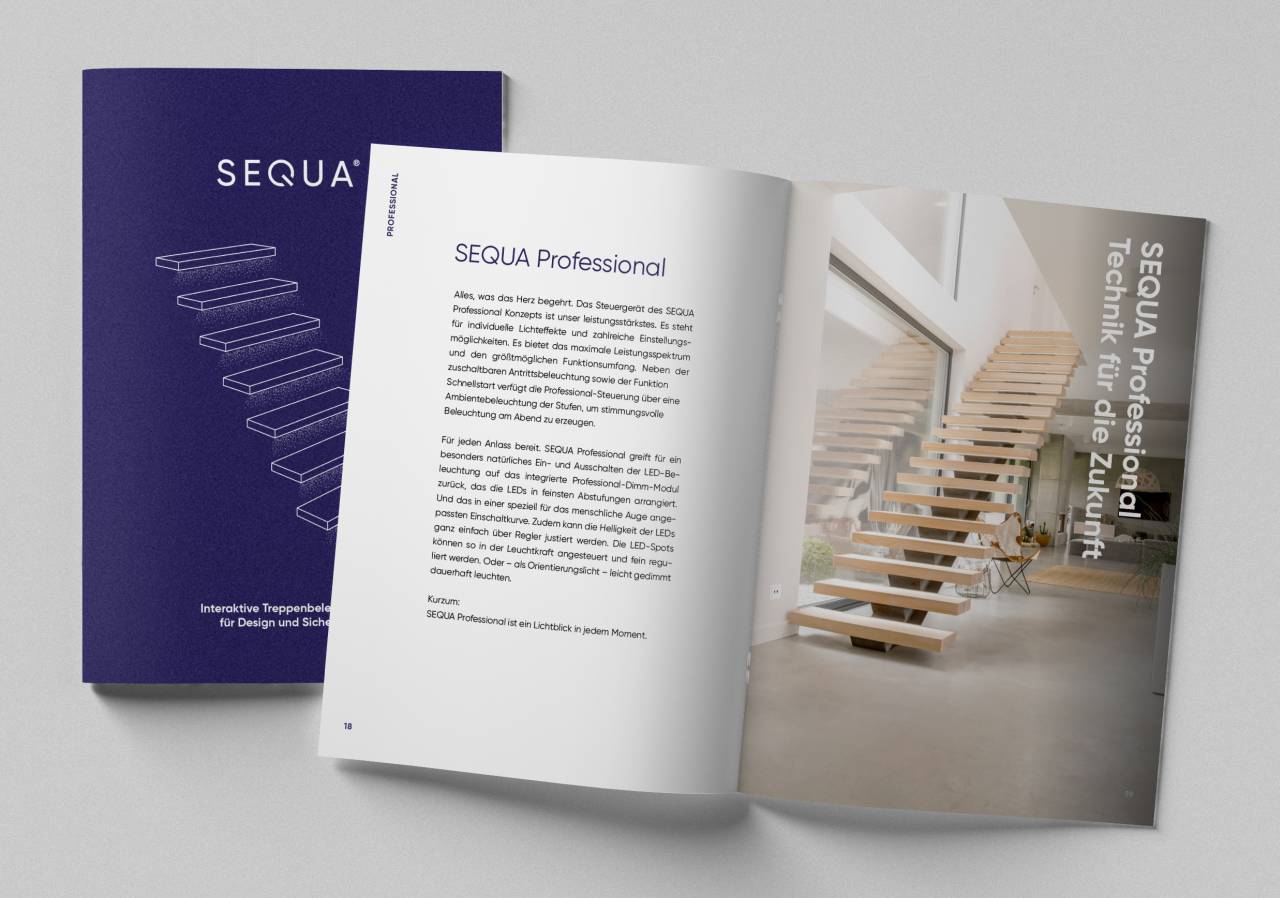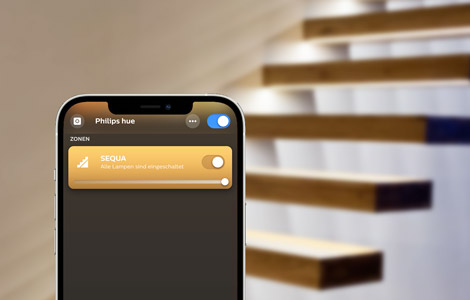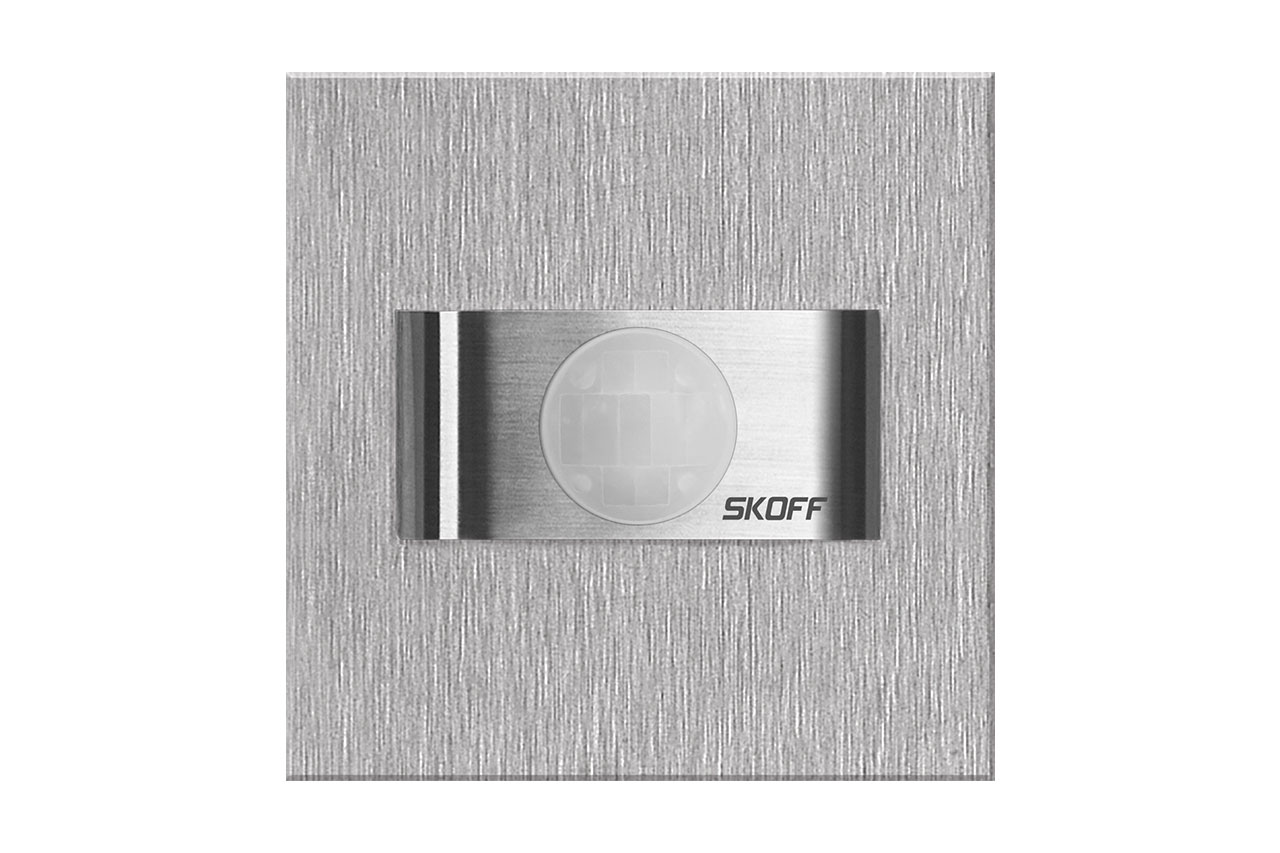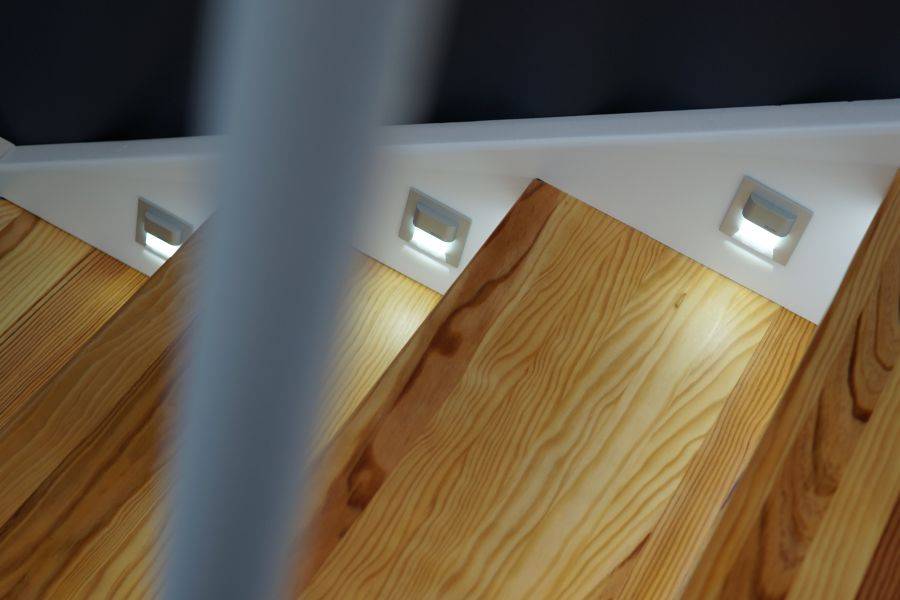SEQUA - Your specialist for staircase lighting for over 10 years

As inventor and market leader in the field of automatic staircase lighting - with now more than 10 years of experience - you are at the right address for your staircase lighting project. Whether open, closed, concrete or cantilever stairs - in thousands of projects we have successfully illuminated the most diverse types of stairs. Also for your staircase - no matter if end customer, or expert in the field of electrical, or stairs - together we will find a tailor-made solution, which will give you many years of pleasure!
In the following sections we would like to give you an overview of the different types of staircase lighting. We present here the different control options, light source types and our lighting recommendations for different types of stairs. Should any questions remain unanswered, we will be happy to provide you with advice and assistance at any time. Please use our Contact formto formulate your questions. No matter how simple or complicated they may be - we will be happy to answer them.
PS: Our new product brochure is now available for download. Do you need a printed copy for yourself or your customers? A short message via our Contact form is all it takes.
The different control possibilities of staircase lighting
Whether classically by changeover, with sensor-controlled automatic, switched via the smart home control, or time-controlled at sunrise and sunset: There are countless ways to control a staircase lighting to suit your needs. Here we present the most common variants of staircase lighting controls:
The staircase lighting with sensor-controlled automatic
Probably the most comfortable and at the same time most impressive way of staircase lighting control is the sensor-controlled automatic system from SEQUA. The two motion sensors of the staircase lighting detect the use of the staircase and activate the step-by-step lighting: As if by magic, the staircase wraps itself step by step in warm white light. This animated staircase lighting with running light effect can be easily implemented with a SEQUA LED control unit. In dark hallways, the additional presence detector keeps you from suddenly being in the dark - unlike staircase lighting control by timer, which unexpectedly switches off the light and you have to search for the next pushbutton switch first. You will find all details about the SEQUA controls in the next Tab "LED control units.
The switching of the staircase lighting via permanently connected switches (also by changeover)
For the retrofit of a staircase lighting with more modern LEDs it is possible to use the existing cables and light switches - also change-over switches. In case of a 1 to 1 exchange, LED spotlights are mandatory for direct connection to the house mains. Alternatively, a suitable LED power supply is required for the operation of LEDs - details on this can be found below in the section "The voltage types of staircase lights - from battery, via 10 V, to 230 V". In the Category "Power supplies we offer a large selection of suitable LED power supplies, so that also the retrofitting of your staircase lighting succeeds optimally.
The control of the staircase lighting by home automation
 Controlling your staircase lighting by home automation is a convenient way of staircase lighting control. In the case of automation in new buildings, mainly permanently connected control systems - such as KNX, or Loxone - are used. These systems are capable of directly controlling the staircase lighting via relay or dimming actuators. More comfort can be achieved in combination with a SEQUA LED control unit: While the latter takes over the precise sensor-controlled step-by-step switching of the staircase lighting - a task that no home automation system is able to implement so perfectly - the home automation system coordinates integral functions such as switching off during daylight, or activating the permanent light function. A win-win combination for your staircase lighting in the smart home environment!
Controlling your staircase lighting by home automation is a convenient way of staircase lighting control. In the case of automation in new buildings, mainly permanently connected control systems - such as KNX, or Loxone - are used. These systems are capable of directly controlling the staircase lighting via relay or dimming actuators. More comfort can be achieved in combination with a SEQUA LED control unit: While the latter takes over the precise sensor-controlled step-by-step switching of the staircase lighting - a task that no home automation system is able to implement so perfectly - the home automation system coordinates integral functions such as switching off during daylight, or activating the permanent light function. A win-win combination for your staircase lighting in the smart home environment!
In our Advisor article "Staircase lighting in home automation" we show all possibilities in detail.
In the renovation of old buildings, current systems also allow the retrofitting of home automation via radio to control the step LEDs. The Zigbee radio standard is often used here, as it can be easily connected to common systems such as Philips hue, or Amazon Alexa. Our Zigbee adapters for staircase lighting control also rely on this standard, which can also be used to control the staircase lighting directly, or as a supplement to an LED controller. In our Store category "Wireless and smart home solutions" you will find the right products for integrating staircase lighting into your smart home.
Motion detectors for staircase lighting control
 Especially for our stair lights from SKOFF we offer suitable motion detectors with integrated brightness sensors. Visually made of identical material, SKOFF motion detectors are our first choice for short, or rarely used stairs. A disadvantage of stair lighting with motion sensors is the imprecise switching on of the lighting already in passing - unlike the motion sensors of the SEQUA control units - which is why we recommend the sensor-controlled solution with a SEQUA LED control unit for high-quality lighting in the living room. All details about the SKOFF motion detectors we have in the article description information we have compiled for you.
Especially for our stair lights from SKOFF we offer suitable motion detectors with integrated brightness sensors. Visually made of identical material, SKOFF motion detectors are our first choice for short, or rarely used stairs. A disadvantage of stair lighting with motion sensors is the imprecise switching on of the lighting already in passing - unlike the motion sensors of the SEQUA control units - which is why we recommend the sensor-controlled solution with a SEQUA LED control unit for high-quality lighting in the living room. All details about the SKOFF motion detectors we have in the article description information we have compiled for you.
Control of the light by timers (astro time relay)
Another alternative we would like to present to you is the control of the staircase light by timer. In contrast to older clocks, current models are capable of switching the lighting to match the sunrise and sunset: the astro time function. This way, the switching on of your staircase light adapts to the season instead of always going on and off at the same time. Tip: The Astro timer can also be used in combination with a SEQUA control unit. Use the sensor-controlled automatic of the SEQUA staircase lighting, while the automatic is deactivated by timer during the day. You will find all details in the Article description of the astro time relay.
The different types of LEDs for staircase lighting
For the optimal staircase lighting, different illuminants come into question depending on taste and staircase type. The choice of LED illuminants also determines the character of the staircase lighting: whether elegant LED spotlight on the wall, the LED strips in the steps that are completely invisible when switched off, or the RGBW variant for a colorful staircase light. No matter which lighting solution you prefer for your staircase, we are happy to offer you the appropriate illuminants for it.
Classic staircase lighting with recessed LED spotlights in the wall
The recessed versions of our LED spotlights, such as the Tango spotlight from SKOFF, are suitable for regular 60 mm switch boxes (also called 68mm flush-mounted boxes) and can be easily mounted in them with the integrated clip. No gluing, no screwing - and plenty of space to connect the connection cables with the optional WAGO clamps from our connection cable set. The flat spotlight protrudes only a few millimeters from the wall and provides glare-free illumination of the steps with its downward directed light. You can find out more about LED staircase lighting with wall-mounted spotlights in our Product category "LED spotlights.
Staircase lighting with surface-mounted spotlights on the stair string (surface-mounted, flat, retrofit, cable duct)

The surface-mounted versions of our LED spotlights - such as the Surface-mounted spotlight Tango Mini from SKOFF - can be glued directly onto the staircase string - only a small hole in the string is then required for the connection cable. This makes the surface-mounted LED spotlights also interesting for the subsequent installation of staircase lighting.
Often, with new wooden stairs, the connection cables can be laid completely invisibly in a cable channel milled into the back. For fastening, we recommend the industrial adhesive tape offered in the store, which guarantees optimum hold on the stair string, but can still be removed without leaving any residue. Surface-mounted spotlights are also equipped with directional light for glare-free illumination.
You can find out more about LED staircase lighting with surface-mounted spotlights in our Product category "LED spotlights.
Step lighting with LED strips in aluminum profile
Completely invisible when switched off, step-by-step staircase lighting with LED strip lights creates a particularly stunning lighting effect. The uniform illumination of the entire width of the stairs also provides a plus in safety. For this purpose, the aluminum profiles for the LED strips are either attached directly below each tread near the front edge by bonding or recessed in a groove to be milled. The small LED lights (either 60 per meter, or a full 120 per meter) in the light strip give the steps a homely glow - in atmospheric warm white if desired. The strips can be adjusted in length on site to the width of each individual stair tread and can be shortened every 5 cm with scissors. You can find all details about stair lighting with luminous strips in our Product category "LED strips.
Colorful staircase lighting with RGBW strips in the steps
In addition to the single-color LED strips, colored, so-called RGBW LED strips can also be used to illuminate the staircase. Also to accommodate the RGBW light strip, a narrow groove is milled for the aluminum profile under each stair tread and the strip is glued into this. Our range includes both the RGBW LED strips and the matching RGBW controller. In our Guide article "Staircase lighting with RGB(W) LEDs we have compiled all the details for you.
The voltage types of stair lights - from battery, over 10 V, to 230 V
LED illuminants are available in many different variants, sockets and also voltages. For an LED staircase, bulbs from 10 V to 24 V are often the first choice, as they are efficient, long-lasting and cost-effective. We would like to introduce these, and the alternatives to staircase lighting for this in this section:
10 V to 24 V illuminants
The most common LED illuminants for staircase lighting are powered by voltages of 10 V, 12 V, or 24 V: These are easy to handle and safe to operate. The connection of the LEDs can not be made directly to the house network, but is made with the help of an intermediate LED power supply. This is often also called transformer, or ballast and is to be selected in principle from the voltage suitable for the connected LED staircase lights: A 10 V power supply is required for a 10 V spotlight, a 12 V power supply for a 12 V spotlight and a 24 V power supply for a 24 V LED strip. Tip: Our Staircase lighting configurator automatically selects the right power supply for your selected LEDs in terms of voltage and power - try it out right away!
Staircase lighting LEDs for direct mains connection (230 V)
The most important thing in advance: Work on the 230 V network must always be carried out by a qualified electrician! Staircase lighting for direct connection to the 230 V mains often has an integrated power supply unit. This is practical if only individual LEDs are to be used for staircase lighting, or if the staircase lighting is retrofitted to existing lines during staircase renovation. The retrofitted LEDs can thus be operated directly with the mains voltage without having to add a power supply unit. However, as soon as several LEDs are used for lighting, a central power supply unit for all illuminants, instead of one power supply unit per illuminant, makes more sense. This is more efficient and also helps to avoid unnecessary power supplies and thus costs. In the case of our LED recessed spotlights from SKOFF, the Power supply even behind the LED spotlight in a switch box can be mounted and supplies up to 14 other spotlights from there.
Battery operated staircase LED lights
We can not recommend battery operated staircase lighting without cables in most cases. Due to the battery operation, the lights are relatively large, the motion detectors for control are inaccurate according to experience, and the light output is often insufficient. The additional expense of the wired connection of the LEDs therefore pays off (over time) in many respects: Neither is the battery empty at inopportune moments, nor does it need to be replaced, or charged, at regular intervals. Wired staircase lighting saves nerves, resources and provides optimal illumination of the staircase over a long period of time.
Staircase lighting on different types of stairs
Depending on the staircase to be illuminated, LED spotlights, or LED strips can play out their individual advantages. In the following table we have listed common types of stairs and our recommendations and tips on lighting for them:
| | LED strips | LED spotlight |
|---|
| Cantilever staircase | Consider cable routing/connection at the end of the step | Wall recessed spotlights for switch boxes |
| Concrete stairs | Plan cable routing in advance (empty tubes) | Wall recessed spotlights for switch boxes |
| Folding staircase | Not possible, as there is no step-over | Wall recessed spotlights for switch boxes |
| Spiral staircase | Possible, provided there is a step-over | Small spotlights, preferably glare-free |
| Spiral staircase | Possible, provided there is a step-over | Small spotlights, as glare-free as possible |
| Bolt staircase | Cable routing more difficult, through the gap between wall and step | Wall recessed spotlights for switch boxes |
| Wooden stringer staircase | Provide cable routing optimally in stringer. | Surface-mounted LED spotlights and Optimally provide cable routing in the stringer. |
| Steel stringer staircase | Consider drilling for the supply lines to the step - ideally already during construction | Consider surface-mounted LED spotlight and drill hole for the supply lines - ideally already during construction |
| Middle rail staircase | Route cables in the step to the center stair | If not free-standing: wall recessed spotlights for switch boxes |
The table is based on our experience and can of course vary individually from stair to stair. Details, as well as pictures of examples of different types of stairs can be found in our guide "Lighting different stairs".